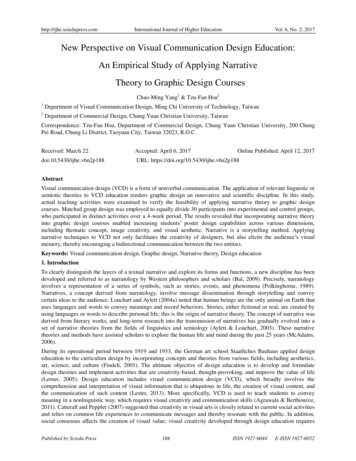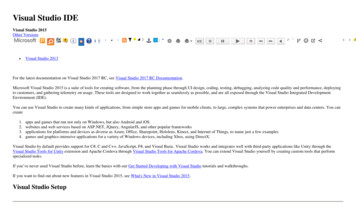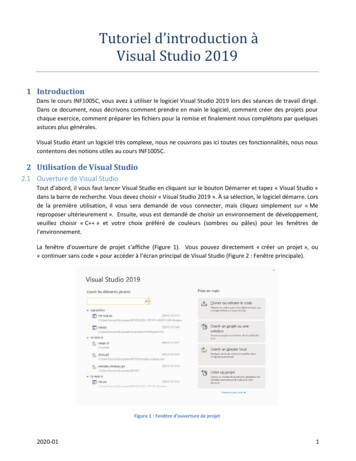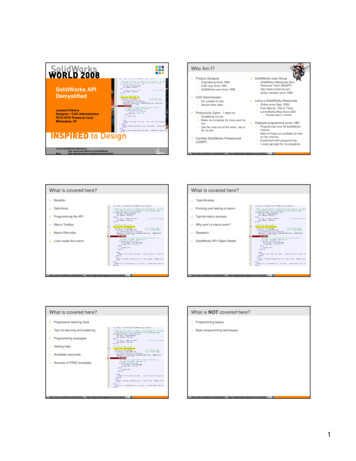
Transcription
http://ijhe.sciedupress.comInternational Journal of Higher EducationVol. 6, No. 2; 2017New Perspective on Visual Communication Design Education:An Empirical Study of Applying NarrativeTheory to Graphic Design CoursesChao-Ming Yang1 & Tzu-Fan Hsu21Department of Visual Communication Design, Ming Chi University of Technology, Taiwan2Department of Commercial Design, Chung Yuan Christian University, TaiwanCorrespondence: Tzu-Fan Hsu, Department of Commercial Design, Chung Yuan Christian University, 200 ChungPei Road, Chung Li District, Taoyuan City, Taiwan 32023, R.O.C.Received: March 22Accepted: April 6, 2017Online Published: April 12, 2017doi:10.5430/ijhe.v6n2p188URL: l communication design (VCD) is a form of nonverbal communication. The application of relevant linguistic orsemiotic theories to VCD education renders graphic design an innovative and scientific discipline. In this study,actual teaching activities were examined to verify the feasibility of applying narrative theory to graphic designcourses. Matched group design was employed to equally divide 30 participants into experimental and control groups,who participated in distinct activities over a 4-week period. The results revealed that incorporating narrative theoryinto graphic design courses enabled increasing students’ poster design capabilities across various dimensions,including thematic concept, image creativity, and visual aesthetic. Narrative is a storytelling method. Applyingnarrative techniques to VCD not only facilitates the creativity of designers, but also elicits the audience’s visualmemory, thereby encouraging a bidirectional communication between the two entities.Keywords: Visual communication design, Graphic design, Narrative theory, Design education1. IntroductionTo clearly distinguish the layers of a textual narrative and explore its forms and functions, a new discipline has beendeveloped and referred to as narratology by Western philosophers and scholars (Bal, 2009). Precisely, narratologyinvolves a representation of a series of symbols, such as stories, events, and phenomena (Polkinghorne, 1989).Narratives, a concept derived from narratology, involve message dissemination through storytelling and conveycertain ideas to the audience. Louchart and Aylett (2004a) noted that human beings are the only animal on Earth thatuses languages and words to convey meanings and record behaviors. Stories, either fictional or real, are created byusing languages or words to describe personal life; this is the origin of narrative theory. The concept of narrative wasderived from literary works, and long-term research into the transmission of narratives has gradually evolved into aset of narrative theories from the fields of linguistics and semiology (Aylett & Louchart, 2003). These narrativetheories and methods have assisted scholars to explore the human life and mind during the past 25 years (McAdams,2006).During its operational period between 1919 and 1933, the German art school Staatliches Bauhaus applied designeducation to the curriculum design by incorporating concepts and theories from various fields, including aesthetics,art, science, and culture (Findeli, 2001). The ultimate objective of design education is to develop and formulatedesign theories and implement activities that are creativity-based, thought-provoking, and improve the value of life(Lerner, 2005). Design education includes visual communication design (VCD), which broadly involves thecomprehension and interpretation of visual information that is ubiquitous in life, the creation of visual content, andthe communication of such content (Lester, 2013). More specifically, VCD is used to teach students to conveymeaning in a nonlinguistic way, which requires visual creativity and communication skills (Agrawala & Berthouzoz,2011). Catterall and Peppler (2007) suggested that creativity in visual arts is closely related to current social activitiesand relies on common life experiences to communicate messages and thereby resonate with the public. In addition,social consensus affects the creation of visual value; visual creativity developed through design education requiresPublished by Sciedu Press188ISSN 1927-6044E-ISSN 1927-6052
http://ijhe.sciedupress.comInternational Journal of Higher EducationVol. 6, No. 2; 2017inspiration from cultural and life experiences (Csikszentmihalyi, 1991). Visual communication involves the processof communication and persuasion and the shaping of cultural value. Thus, visual design can influence lifestyles andshape identification with social and cultural values.Although design has been considered as a branch of fine art since the 15th century, it is actually a distinct field(Frascara, 1988). From the perspective of artistic creation, design combines both a rational and a perceptual process,differs from fine art in terms of technique, and can become a scientific and systematic discipline through adequateprinciples or theories. Therefore, the present study applied narrative theory to visual design education. Althoughnarratology was first proposed by French scholar Tzvetan Todorov in 1966, it did not receive much attention until1985 (Bal, 2009). From the perspective of design applications, narratology pertains to a noval design concept thathas been widely adopted by both design practitioners and scholars. Long-term observation of design exhibitions andstudent design competitions in Taiwan indicates that design students’ originality has begun to fade in recent years;especially as technological advancement has produced numerous design application programs. Such programs haveslowly disrupted students’ design originality and resulted in more emphasis placed on the effect displayed by designrather than on the essence of design. In this study, narratology was employed to examine whether narrative theorycan be used to create a nonconventional and innovative instruction model for VCD education.2. Literature Review2.1 Summary of Narrative TheoriesThe term narratology was originally proposed by French scholar Tzvetan Todorov in 1966 in his book, Grammairedu Décaméron (Genette, 1983). Since the 1970s, narratology has sparked enormous attention and discussion in thefield of literature (Bal, 2009). The use of narratives dates back to prehistoric societies, in which mythological storiesand logographic writings were created to describe events or convey messages, marking the start of narrative activities(Roberts, 2001). Although narratives were mostly applied to myths and folklore in early times, any visible andsensible materials or symbols can be used as a narrative element (Willams, 2009). Thus, narratives are a basicpathway for understanding a society or reflecting the world or personal life (Bal, 2009). Narratology research wasinitially prompted by French structuralism and has only become an international trend in recent years. Structuralistnarratology shifted the attention from the external structure of texts to their internal structure, stresses the importanceof scientific and systematic procedures, and focuses on examining the pattern of internal structures of a narrative textas well as the relationship between all elements within the text (Roberts, 2001).Narratology was previously regarded as a branch of structuralism. However, structuralism originated from the Swisslinguist Ferdinand de Saussure’s theory of the linguistic sign, which suggests an intimate relation between language,sign, structure, and narrative (Fludernik, 2005). From the perspective of storytelling, the basic structure of a narrativeconsists of a story, a discourse, and a narration; such structure transforms an event into a linear organization that hasthe form of a story. When the narration is formalized (i.e., the message is conveyed), this event becomes the text of astory (Landa & Onega, 2014). In other words, a story refers to the description provided by a narrative and exhibits anarrative structure and dramatic tension. A narrative discourse is a method for describing a series of events, andnarration refers to the overall process of storytelling. From the perspective of art design, recent narratology theorieshave started to influence design. In its essence, iconology is the narrative design of visual communication (Young,2009). Narrative theory studies emerged in the 1960s and is closely associated with the concept of structuralismproposed in the mid-20th century (Fludernik, 2005). Research in structuralist narratology has mainly focused onstudying literary works, but has in recent years spanned across the fields of art and design (Young, 2009).Narrative studies either in literature or art design can be traced back to Saussure and the American linguist CharlesSanders Peirce, who laid the theoretical foundation for structuralism using their theories of linguistic signs. Americannarratologist Gerald Prince (2013) defined narrative as a combination of events and phenomenon signals. Because asignal can be considered as a sign, narrative theory can be regarded as a novel product of linguistic sign theories.Crucial to narrative theory, a narrative text allows a narrator to narrate a story through a specific medium such aslanguage, image, voice, or architecture (Bal, 2009). Thus, all cultural products with narrative characteristics canconstitute research material (Young, 2009). Human memory relies on narrative forms to memorize events,particularly those that are unorganized and vague (Willams, 2009). If narrative forms can be used to create stories,then lost memories can be retrieved in a disordered state to establish a causal relationship between events. Then,human beings can employ their cognitive predictive ability in transforming contradictory narrative characteristicsinto ideal ones and perform individual creation tasks (Liu, 2008).Published by Sciedu Press189ISSN 1927-6044E-ISSN 1927-6052
http://ijhe.sciedupress.comInternational Journal of Higher EducationVol. 6, No. 2; 20172.2 Visual Communication Design EducationSince the foundation of Bauhaus, design has gradually transformed into a comprehensive discipline, which requiresstudents not only to study design history, cognitive psychology, and semiology, but also to acquire drawing skills(Margolin, 2002). Because of the improved development of design education, VCD has been included as a criticaltraining course in vocational schools, art schools, and high education institutions (Swanson, 1994). In response to thehighly developed commercial society, the position of visual communication designer has gradually been accepted bythe public (Swanson, 1994). Most people also agree that visual communication designers can use their own creativityand aesthetics to generate substantial profits for a customer’s product or service (Swanson, 1994). However, VCD ispresently at a crossroads, at which the past training method of artistic intuition and the current training method oflogical design are in a conflict because the principles of VCD remain unconfirmed and are not fully established in thefield of graphic design (Bennett, 2006).Although graphic design is a rational thinking process (Byrne, 1990), VCD entails the roles of both artists andgraphic designers and involves rational and perceptual designing processes (Newark, 2002). Visual communicationdesigners were often referred to as commercial artists by their customers (Hollis, 2001). However, culturaldevelopment and progress has gradually altered the social perception of VCD and facilitated understanding of thisfield (Frascara, 1988). More precisely, VCD is a product of both an industrial society and a cultural economy (Hollis,2001). The visual style of VCD has been extensively discussed by numerous scholars. However, Frascara (1988)suggested adjustments to several viewpoints on the visual style of VCD. For instance, the importance of visualstructure tends to be overlooked in esthetic contexts; the importance of ideas is generally neglected during theprocess of visual communication; designers often fail to distinguish appropriately between visual creation and visualmanipulation; and designers tend to overlook the importance of public feedback when attempting to convey amessage. These factors have caused graphic design students to mistake VCD for visual arts creation. In fact, they donot involve the same creation process or thinking mode.VCD education has gradually developed in Taiwan by being included in the curricula of departments related tographic design, advertisement design, commercial design, and applied arts. In 1994, VCD was officially separatedfrom industrial design and arts and treated as an individual field in Taiwan, indicating that the core objective ofgraphic design had shifted from commercial problem solving into cultural and social consideration (Tseng, 1996). InVCD education, graphic design is a required course covering the VCD foundations, which are ubiquitous in daily lifeand serves to explain, decorate, and identify (Newark, 2002). Graphic design typically involves selecting images andaligning them onto graphic materials to convey a certain concept (Barnar, 2013). Graphic design works generallyfeature both text and images, which are crucial design elements that generate a complete meaning once integrated.Barnar (2013) defined graphic design as a process of transforming texts and images into signs. New meanings arethus generated when various signs are juxtaposed because each individual sign has its own particular meaning.Therefore, the quality of a graphic design work is not determined by the audience’s comprehension, but rather bywhether the signs used by its designer create a space of imagination by drawing upon the audience’s personalexperience.3. Research Design3.1 Experimental ProcedureA teaching experiment was conducted through university graphic design courses to investigate the application ofnarrative theory to poster design. The objective of this instruction program was to assist students in designing apublic welfare poster. Four weeks of teaching activities were organized for this experimental program, which wasdesigned according to the experiment implemented by Yang and Hsu (2015) and was performed through thefollowing procedures (see Fig. 1):1) Select university freshman students as the experiment participants.2) Request each participant to design a public welfare poster at the beginning of the program; the posters weregraded as the pretest scores.3) Invite three graphic design teachers to determine the pretest scores.4) Input the pretest scores into SPSS 22.0 for ranking. Use the median as the reference point; 15 students withscores closest to the median were selected from each side of the median, totaling 30 participants.5) Apply matched group design and divide the 30 participants into Groups A and B, each comprising 15participants.6) Treat Group A as the experimental group (which received narrative theory instruction) and Group B as the controlPublished by Sciedu Press190ISSN 1927-6044E-ISSN 1927-6052
http://ijhe.sciedupress.comInternational Journal of Higher EducationVol. 6, No. 2; 2017group (which did not receive narrative theory instruction).Figure 1. A flow chart for teaching experiment (Yang & Hsu, 2015)3.2 Pretest and Group MatchingPurposive sampling was employed to select 47 freshman students as the preliminary participants from theDepartment of Visual Communication Design at Ming Chi University of Technology. The inclusion criteria werethose who are aged 18–19 years and have never received graphic design training. Before the experiment was initiated,each participant was asked to design an A4-sized environmental conservation poster within 3 hours. In addition topromoting environmental conservation, each poster required a visual picture, a headline, and a body text, and a reportdescribing the design concept (within 100 words) was submitted after finishing the poster. The posters were used todetermine the pretest scores of the preliminary participants.Three graphic design teachers were recruited to assign pretest scores. The score of each poster was summed up fromfour dimensions, namely, thematic concept (25%), image creativity (25%), visual aesthetic (25%), and expressivetechnique (25%), and averaged between the three teachers. Excluding the posters with outlier scores yielded 41posters for subsequent analysis. The median score was used as the reference point, and 15 students with scoresclosest to the median were selected from each side of the median, totaling 30 students as the final participants (Yang& Hsu, 2015).The pretest scores of these 30 participants were ranked from the highest to the lowest. Matched group design wasadopted to divide these participants into Group A (experimental group) and Group B (control group), comprising 15participants each (Table 1). Different instruction activities were applied to these two groups. After the participantswere matched and grouped, pretest scores from both groups were analyzed to calculate the average score of eachgroup and compared using an independent sample t test, thereby determining whether they exhibited similar designabilities. The mean scores of Groups A and B were determined to be 84.17 (SD 4.23) and 83.86 (SD 4.11),respectively, and the t test revealed a p value of .432 (t .943 and df 28), indicating that the two groups differednonsignificantly (p .05). In other words, before attending the experimental instruction program, the experimentaland control groups did not differ significantly in poster design ability.Table 1. Grouping of the experimental participantsScore orderingS1S2S3S4S5S6S7Group MatchingABBAABBScore orderingS8S9S0 .S28S29S30ABBAABBGroup Matching3.3 Program DesignThe experimental and control groups received 4 weeks of instruction sessions consecutively (one session per weekand 3 hours per session). For each session, the first 1.5 hours were graphic design instruction and the remaining timeentailed student practice. Thus, a total of 720 hours of instruction was administered to the participants. The studentswere asked to select a public welfare topic from the course content (e.g., nuclear safety, human rights promotion,educational equity, and environmental protection), conceive three poster design concepts on the basis of this topic,and select one concept to complete the poster design assignment.The volumes used as teaching materials for this experimental program included: The Essential Principles of GraphicDesign (Millman, 2008), Graphic Design: The New Basics (Lupton & Phillips, 2014), 100 Ideas that ChangedPublished by Sciedu Press191ISSN 1927-6044E-ISSN 1927-6052
http://ijhe.sciedupress.comInternational Journal of Higher EducationVol. 6, No. 2; 2017Graphic Design (Heller & Vienne 2012), Effective Poster Design (Van Dalen et al., 2002), Applying NarrativeTheories in the Design of Public-cause Posters: Process and Educational Implications (Yang & Hsu, 2017).Furthermore, the Analysis, Design, Development, Implementation, and Evaluation (ADDIE) model proposed byMolenda (2003) was adopted to guide both groups to design adequate posters. Both groups studied the same coursecontent during the first week. From the second week onward, the control group was taught using the case methodonly, whereas the experimental group was taught by introducing narrative theory, helping them create posters fromthe a narrative perspective. The course content of the two groups are explained as follows:Experimental group (Group A)1) Week 1 Topic: Introduction to public welfare poster design Content: Define the public welfare poster and introduce public welfare topics from the perspectives ofsociety, economy, and culture to assist learners in conceiving a design concept.2) Week 2 Topic: Narrative approaches and procedures for a public welfare poster Content: Teach the application of narrative theory to poster design, the meaning of iconic signs on a poster,and the procedures of encoding and decoding narratives.3) Week 3 Topic: Application of narrative design to public welfare posters Content: Teach the use of visual languages (e.g., shape, text, and color) to integrate and visualize designconcepts.4) Week 4 Topic: Narrative skills for designing a poster Content: Teach the conception of a design concept through storytelling and the visualization of a publicwelfare poster through the similarity between various objects.Control group (Group B)1) Week 1 Topic: Introduction to public welfare poster design Content: Define the public welfare poster and introduce public welfare topics from the perspectives ofsociety, economy, and culture to assist learners in conceiving a design concept.2) Week 2 Topic: Styles and types of public welfare poster design Content: Classify posters created by renowned graphic designers or those that received international awardsaccording to their design style and type.3) Week 3 Topic: Color and visual expression of public welfare posters Content: Classify posters created by renowned graphic designers or those that received international awardsaccording to their color and visual expression.4) Week 4 Topic: Text and composition of public welfare posters Content: Classify posters created by renowned graphic designers or those that received international awardsaccording to their text arrangement and visual composition.4. Result4.1 Reliability of the JudgesAfter the program was completed, the same three teachers employed for assigning the pretest scores also determinedthe posttest scores, which were summed up according to the same four dimensions as those in the pretest, andaveraged among the three teachers. The posttest scores of both groups were then imported into SPSS 22.0, and aninter-judge reliability test was performed using Kendall’s coefficient of concordance.Published by Sciedu Press192ISSN 1927-6044E-ISSN 1927-6052
http://ijhe.sciedupress.comInternational Journal of Higher EducationVol. 6, No. 2; 2017The reliability test results demonstrated that thematic concept, image creativity, visual aesthetic, and expressivetechnique attained a Kendall’s W value of .912 (p .000), .973 (p .000), .789 (p .003), and .834 (p .001),respectively, implying that these four dimensions all reached the significance level of p .05. In addition, theKendall’s W value for the total score was .953, suggesting a significance level of p .001 (p .000). Thisdemonstrated consistency among the posttest scores assigned by the three teachers. In other words, the posttestscores were adequately reliable and thus suitable for determining the differences in the learning outcomes of thegroups.4.2 Analysis of Teaching AchievementIn the experimental group, the means for thematic concept, image creativity, visual aesthetic, expressive technique,and total score were 22.00 (SD 1.07), 21.87 (SD 1.19), 20.73 (SD 1.06), 20.27 (SD 1.10), and 85.01 (SD 3.25), respectively. In the control group, the means for thematic concept, image creativity, visual aesthetic,expressive technique, and total score were 20.93 (SD 1.73), 20.80 (SD 1.61), 19.87 (SD 1.96), 19.60 (SD 1.91), and 81.20 (SD 5.13), respectively. Moreover, the standard deviations of both groups indicated that,compared with the control group, the experimental group exhibited a higher consistency in the score of eachdimension and the total score (Table 2).Table 2. Average scores and standard deviations of experimental and control groupsGroup A (experimental group)Group B (control group)MSDMSDThematic concept22.001.0720.931.73Image creativity21.871.1920.801.61Visual aesthetic20.731.0619.871.96Expressive technique20.271.1019.601.91Total score84.873.2581.205.13One-way ANOVA was performed to identify statistically significant differences in the four dimensions and totalscore of the groups. The results indicated that, for thematic concept, a significance level of .017 (p .05) wasreached between the groups with F(1, 88) 6.47 (Mexperimental group 22.00 Mcontrol group 20.93); for image creativity, asignificance level of .021 (p .05) was reached between the groups with F(1, 88) 5.95 (Mexperimental group 21.87 Mcontrol group 20.80); for visual aesthetic, a significance level of .031 (p .05) was reached between both groups withF(1, 88) 5.14 (Mexperimental group 20.73 Mcontrol group 19.60); for expressive technique, a significance level of .081(p .05) was not reached between the groups with F(1, 88) 3.27; and for the total score, a significance level of .009(p .01) was reached between the groups with F(1, 88) 7.89 (Mexperimental group 84.87 Mcontrol group 81.20; see Table3).Table 3. One-way ANOVA results for experimental and control groupsSSBetweenThematic concept8.53GroupsWithin Groups 36.93BetweenImage creativity8.56GroupsWithin Groups 40.13BetweenVisual aesthetic5.63GroupsWithin Groups 30.67BetweenExpressive technique3.33GroupsWithin Groups 28.53BetweenTotal score108.31GroupsWithin Groups 384.40*p .05 **p .01 ***p .001Published by Sciedu .317.89.009**8813.73ISSN 1927-6044E-ISSN 1927-6052
http://ijhe.sciedupress.comInternational Journal of Higher EducationVol. 6, No. 2; 20175. Discussion5.1 Constructing a Model of Narrative Design ModelA narrative entails a method of storytelling. In fact, a designer’s job is similar to storytelling. Just as a storytellervividly describes anecdotes heard from the countryside as if they had experienced them, a designer can also applynarrative techniques to VCD, which can not only facilitate the creation of design concepts, but also achieve the goalof mutual communication by retrieving the audience’s visual memory. The present study analyzed the logic ofnarrative possibilities (les possibles narratifs) proposed by Claude Bremond (1929–1973) and applied this logic toconstruct a narrative model for designing public welfare posters. This model was then employed in the proposedexperimental program, in which the experimental group was asked to identify feasible topics and visual images fromrecent news items or stories to design their public welfare posters. This narrative model for public welfare posterdesign was divided into three creation process dimensions: (1) narrative statement, which involves using thelanguages, texts, or words of a causal relationship to address a public welfare topic on the poster; (2) symbolicinstantiation, which requires the transformation of a narrative statement into feasible symbols; and (3) techniqueapplication, which involves presenting a poster through different design techniques (see Fig. 2).The application of narrative design to a public welfare poster involves several procedures. First, an authentic newsitem or story is used as the inspiration for designing the poster. The news item or story is then examined under thedimension of narrative statement, which generates keywords by analyzing the language, text, or expression of thenews item or story. Under the dimension of symbolic instantiation, these keywords are then transformed intosymbols, and a poster draft is produced according to the characteristics of these symbols. The draft is then examinedunder the dimension of technique application, which requires the designer to select adequate techniques to completethe poster design using their own judgment. The creation procedures of the proposed narrative design model can beillustrated as follows: (1) Find a public welfare topic for the poster: select an appropriate topic related to social,environmental, human rights, or peacemaking issues; (2) Determine a narrative subject: select an authentic news itemor story from a media report; (3) Apply narrative statements: analyze the language, words, or text sequences of thenews item or story; (4) Perform symbolic instantiation: transform the narrative statements of the news item or storyinto feasible symbols; (5) Generate a poster draft: produce a poster draft according to the characteristics of theobtained symbols; and (6) Techniques application: determine adequate design techniques to showcase the creativenarrative concept of the poster (Table 4).Figure 2. Narrative design model for public-cause postersPublished by Sciedu Press194ISSN 1927-6044E-ISSN 1927-6052
http://ijhe.sciedupress.comInternational Journal of Higher EducationVol. 6, No. 2; 2017Table 4. The narrative of a public-cause poster concerning human rights issueA news article content“Human Harvest: China’s Organ Trafficking”Dimension ofnarrativestatementA new documentary produced by Australia’s SBS Dateline presents evidence from an investigation done byNobel Peace Prize nominees David Kilgour and David Matas, and sheds new light on the organ harvestingthat to this day is occurring in China. Every year about 10,000 organs are harvested in China, yet there isa small number of people in the official donor list. So, from where does the majority of organs beingharvested comes from? The documentary gives evidence, including testimonies from nurses and surgeonswho have come forward to explain that prisoners, including political prisoners/prisoners of conscience areused to harvest organs used in the multi-billion dollar industry.(Source: ension ofnarrativestatementDimension ofsymbolicinstantiationCharacter appearsPsychological desireAction producingResult finallyChina govermentCovet after wealthInhuman crimes, Organtrafficking, looting etc.Painful, Sufferers,Death, fear etc.Symbol of characterSymbol of desireSymbol of actionSymbol of outcomeChina’s flag, Map of acountry etc.Money, Gold,Renminbi etc.Scalpel, Scissors,Handcuffs, Chain etc.Tears, Crying, bleeding,deperation etc.Technique of expression and operation of practiceDimension oftechniqueapplying5.2 Performance on Visual Creation for Designing PostersWith the development of adva
VCD education, graphic design is a required course covering the VCD foundations, which are ubiquitous in daily life and serves to explain, decorate, and identify (Newark, 2002). Graphic design typically involves selecting images and aligning them onto graphic materials to convey a certain concept (Barnar, 2013). Graphic design works generally











